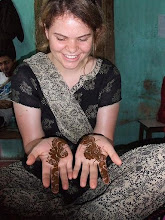Dear dedicated reader,
A few days ago we visited more schools for the Foundation in the hopes of finding good sites for expansion. These visits were as equally interesting and thought provoking as the last, though for different reasons.
For the first, I offer you a profile of Mandvi High School: 4000 students, 1-12, ~100 teachers. Average class size: 115. In some of the classes that I observed at Mandvi, there were so many students in the class that the teacher had literally no room to move around and had to stand stationary next to the front row desks which were just the beginning of the rows and rows which had been crammed into the every room.
The principal of Mandvi couldn’t have been nicer but even he seemed overwhelmed by the capacity issue. “How to teach 115 when they are in a class?” He said with a shrug. “I don’t know.”
In each class I saw, some students were busily copying away what was on the board and attentively listening to their teacher while others, especially those in the back row, were asleep. Outside of the classrooms, some students sat, dozing during their physical education class, or simply talking to their friends in a field next to the school. When the principal took us on a tour of the grounds, I watched two boys in blue uniforms scramble quickly over a fence and run as they saw the principal coming. With so many students, how can one possibly keep track of them all?
Our visit here was short lived. It seemed like the kind of school that one could easily get lost in.
As we pulled up to the next school that we were to visit, Varkel, the principal of Kadod High School turned to us.
“This school,” he announced, “got one hundred percent in their exams last year.”
Kadod High School and Varkel School and all of the schools that I’ve mentioned in this blog so far, are schools whose populations are made up of at least 85% SCST students. SCST is a common abbreviation here in India meaning ‘scheduled castes and scheduled tribes’ or students for whom there are special provisions made in both the Indian constitution and the local state constitution. These special provisions can include extra resources or funding for schools that have these students, special spots reserved for these people in state administrative positions, and other types of reservations. It is, as I understand it, India’s way of addressing problems of not only representation but also histories of institutionalized inequality.
I was anxious to see what this school Varkel was doing so right with the education of these students that they were getting 100% in their exams.
After the perfunctory introductions, the principal of Varkel took us on a proud tour of the school. As directed by the Foundation, we told him that we were most interested in the English program and the computer labs, but our tour was comprehensive. As we made our way into the biology lab, he told us that the school was open 365 days of the year.
“We have school here everyday!” He announced to us, waiting for our reaction.
“Really?” I asked. “Everyday?”
“The teachers come here everyday, no days off. The students can come here anytime to study. They have school 7 days a week, half day on Sunday,” he explained.
I pondered his words and my mind flitted to my other would be life as a KIPP teacher, the one I might have been pursuing if I wasn’t here. If you are unfamiliar with the Knowledge is Power Program model, these are a network of charter schools in low-income, low-access areas in the US that have extended the school day from 7:45 am to 5 pm to increase the opportunity to impact student achievement and have half days on Saturday. Their teachers are given cell phones which they must have on until 9 o’clock at night so students can call for homework help. Could I have stumbled on KIPP India?
As we went through the school, it was clear that the principal wouldn’t be interested in an initiative like ours at his school, but I was captivated by what I saw around the school. It was 2000 students strong, similar to Kadod High School, but everywhere we went, I saw students studying, reading books. Even students with free periods who were sitting outside were reading.
The man who was assisting the principal in the school tour told me that the principal had won an award for best principal in Gujarat. “He’s also the president of the principal’s association in this area,” he confided to me. I eyed the man in question, who was in the middle of telling us about the schools’ award winning Kho-Kho team (an Indian sport that would be too complicated to explain here. Needless to say you won’t be watching them televised in Beijing).
“Three hundred of our five hundred 12th standard students go on to college,” he explained as we headed back to his office for tea after our tour. I was impressed, though saddened that this was an impressive statistic.
As we left the school, I couldn’t help thinking that I’d want to come back and observe this remarkable school more. These thoughts were shatteed by a single sentence from the principal of Kadod High School.
“What did you think of the school?” He asked.
“I was very impressed,” I said honestly.
“Yes, they are good, but not as good as Kadod High School,” he said thoughtfully. “You see, they cheat in their exams. They let their students use their books.”
I was taken aback. “Really?”
“I was appointed by the state to look into it two years ago,” he explained.
KIPP India? Perhaps not.
Best,
Cat
Subscribe to:
Post Comments (Atom)




No comments:
Post a Comment